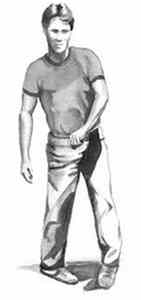

MedFriendly®


Spastic Gait
Spastic gait (shown to the right) is an abnormal type of gait (way of
walking) in which the legs are weak and stiff, and in which there is no
flexing at the knee and ankle. With each step, the leg rotates away from
the body, then towards it, forming a half circle. The toes may also drag
while walking. Sometimes the legs cross while the person walks, causing
a scissor-like gait. Spastic gait is caused by one-sided, long-term muscle
contractions. A contraction is shortening and thickening of the muscles.
Several conditions can cause such long-term muscle contractions, such
as head trauma, stroke, brain cancer, and multiple sclerosis. A stroke is a
burst artery (a type of blood vessel that carries blood away from the
heart) or a blockage of an artery in the brain. Cancer is an abnormal
growth of new tissue characterized by uncontrolled growth of abnormally
structured cells that have a more primitive form.
FEATURED BOOK: Gait Analysis: Normal and Pathological Function
Multiple sclerosis (also known as MS) is a condition in which people develop multiple
areas of abnormal patches (also known as plaques or sclerosis) in the brain and/or spinal
cord (depending on the stage of the illness).
Doctors usually recommend that patients with spastic gait receive treatment from a
physical therapist, at least in the beginning. The physical therapist can then teach the
person exercises to do at home. For spastic gait, physical therapists usually recommend
both active and passive movements. Active movements are ones the patient does by
him/herself, whereas passive movements are movements assisted by others.
"Where Medical Information is Easy to Understand"™
The most important part of physical therapy for spastic gait is to
strengthen any muscles that are weakened as a result of the
spasticity. There are no specific exercises that are recommended
for spastic gait. The exercises chosen will depend on the physical
therapist and what the patient can tolerate. Depending on the
patient, walking, swimming, and leg lifts can help. Leg lifts involve
lying on one's back and lifting one or more legs in the air, holding it
slightly off the ground for 10 seconds and then stopping. This is
often repeated 10-20 times. Slow, prolonged stretching can also
treat spasticity because it helps maintain the full range of motion of
a joint, preventing the muscles from shortening. A joint is a place
where two bones contact each other.
For the stretching activities to work, they need to done regularly, usually once or twice a day. Leg braces
can help keep the foot aligned when the person stands and walks. If poor balance occurs, use of a cane
or walker is generally recommended by doctors and physical therapists.
Spastic comes from the Greek word "spastikos", meaning "drawing in." Gait comes from the Old Norse
word "geta" or "gata," meaning "a way." Put the two words together and you get "a way of drawing in." The
"drawing in" part refers to muscle movements that shorten or are drawn in during a spasm.















